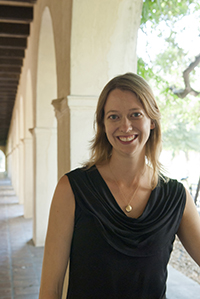
Bethany Ehlmann, who graduated from WUSTL in 2004 with a bachelor’s degree in earth and planetary science, joins a roboticist, an astrobiologist, a glaciologist, an artist and an entrepreneur as one of 17 visionary, young trailblazers from around the world who have been selected as this year’s National Geographic Emerging Explorers.
National Geographic’s Emerging Explorers Program recognizes and supports uniquely gifted and inspiring adventurers, scientists and innovators who are at the forefront of discovery, adventure and global problem-solving while still early in their careers. Each Emerging Explorer receives a $10,000 award to assist with research and to aid further exploration.
The new Emerging Explorers are introduced in the June 2013 issue of National Geographic magazine, and comprehensive profiles can be found at http://www.nationalgeographic.com/emerging
“As National Geographic celebrates its 125th anniversary year and looks forward to embracing a new age of exploration, we look to our Emerging Explorers to be leaders in pushing the boundaries of discovery and innovation. They represent tomorrow’s Robert Ballards, Jacques Cousteaus and Jane Goodalls,” said Terry Garcia, National Geographic’s executive vice president for Mission Programs.
After earning her bachelor’s at WUSTL, Elhmann continued her studies as a Rhodes Scholar at Oxford University. She earned a PhD from Brown University in 2010. She now conducts research on how weathering processes have changed the surface of Mars and other terrestrial planets as a research scientist at NASA’s Jet Propulsion Laboratory (JPL) and as an assistant professor at the California Institute of Technology, both in Pasadena, where Curiosity’s mission control is headquartered.
In her current role as a participating scientist with the Curiosity mission, Ehlmann is using the rover’s Chemistry and Camera instrument, known as “ChemCam,” to remotely fire a laser that will blow holes in rocks and create clouds of atoms that indicate the chemical composition of the rocks.
As Ehlmann told the The Chronicle of Higher Education in a recent news article, this is the first time anyone has zapped rocks with lasers on another planet. The laser, she says, will vaporize a patch of the Mars surface, creating a plasma. Light emitted from the plasma forms a “fingerprint” based on the particular atoms that make up the rock. By looking at the ratios of these elements, researchers may be able to determine whether the rocks were formed by upwelling groundwater or by settling sediments in a lake.
“”It would be a grand-slam home run.” Ehlmann says,”if we find enhanced carbonates, particularly organic carbon, because that could tell us that Mars might even have been inhabited long, long ago. But there’s a lot of ifs to that, and we’re still a long way away from it.”